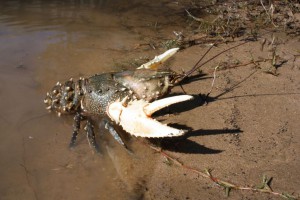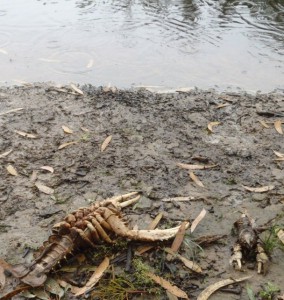Managing the recovery of Murray crayfish in the southern Murray-Darling Basin
Murray crayfish (Euastacus armatus) is the world’s second largest freshwater crayfish and naturally occurs across 12,500km of Victorian and New South Wales waterways of the southern Murray-Darling Basin (MDB), including the River Murray. Yet, this iconic and recreationally fished species has undergone considerable declines in distribution and abundance over the past 50 years due to river regulation, habitat degradation and overfishing.
Most recently, the species has been severely impacted by a hypoxic blackwater event that occurring following drought-breaking flooding over the MDB during 2010–11. Hypoxic blackwater can result as microbes breakdown accumulated leaf litter when floodplains are inundated and can lead to oxygen concentrations (<2mg/l) that are and is lethal to aquatic fauna. In the River Murray, the blackwater originated in the floodplain wetlands, including the Barmah-Millewa and Koondrook-Perricoota redgum forests, as well as along tributary rivers such as the Goulburn and Murrumbidgee rivers, with hypoxic conditions extending for approximately 1800km and persisted for almost six months.
During the 2010–11 blackwater event, fish and yabby kills and the emergence of Murray crayfish were noted. Concerns raised by these observations prompted targeted sampling in 2012 (after data) to allow comparison with data obtained before the blackwater event (in 2010). This study highlighted an alarming reduction (81%) in crayfish abundance in areas affected by the blackwater event whereas abundance remained similar in unaffected upstream areas. Consistently, surveys by NSW DPI have revealed low and patchy numbers of Murray crayfish across other MDB waterways after the blackwater event. These impacts prompted major changes to the recreational fishing regulations for Murray crayfish, including complete closure in blackwater affected areas.
Since this time, research and monitoring as part of a collaborative project (NSW Fisheries and Aquasave–NGT) has shed light on the status of the species. A population genetics study revealed that populations across much its present range are generally in good genetic condition (broad gene flow and moderate genetic diversity), but recolonisation of areas impacted by the blackwater impact will occur gradually. We have also developed a population model to forecast recovery trajectories and assess management scenarios to assist management of the species. Further, we have continued the target blackwater monitoring (in 2014, 2015, 2016 and 2017), which is slow recovery of affected populations, with is consistent with outcomes of population modelling. We have just finalised the most comprehensive benchmarking of the status of populations across Victoria ever conducted, which demonstrated long-term declines at key sites with the present population now largely restricted to only three areas. We have conducted surveys in the South Australian section of the Murray River, where the species has not been detected for almost 30 years, in the hope of re-discovering the species. We have undertaken the first official translocations of the species in almost a century! The translocations occurred in a section of the Murray River that has not recovered since the blackwater event, and will continue in the future.
Components of the research and monitoring have been funded through the NSW Recreational Fishing Freshwater Trust and the Victorian Recreational Fishing Grants Program, with additional funding from the Victorian Department of Environment, Land, Water and Planning.
Please contact Nick or see publications below for more information:
Whiterod, N. & Zukowski, S. (2017). ‘The status of the Murray crayfish recreational fishery in Victoria‘. A report funded by the Victorian Government using Recreational Fishing Licence fees. Aquasave – Nature Glenelg Trust, Goolwa Beach.
Whiterod N.S., Zukowski S., Asmus M., Gilligan D., & Miller A.D. (2017). Genetic analyses reveal limited dispersal and recovery potential in the large freshwater crayfish Euastacus armatus from the southern Murray–Darling Basin. Marine and Freshwater Research, 68, 213–225.
- A busy winter for the aquatic team, with a second release of Murray Crays into SA waters 29/07/2024
- How do you remotely track a Murray Crayfish? 28/08/2023
- After 40 years, Murray Crayfish have returned to South Australia! 29/05/2023
- The tale of two freshwater crayfish 27/02/2023
- Postponed – Mighty Murray Crayfish Community Day – postponed due to high river flows 23/08/2022
- Murray Crayfish get out and about in cold weather as NGT conducts annual monitoring 14/06/2022
- Volunteers get crafty for crays 27/04/2021
- Nick’s Churchill Fellowship: Costa Rica & US … and the Snot Otter! 29/08/2019
- One step closer to re-establishing a keystone species, Murray Crayfish, in South Australia 13/03/2019
- Murray Crayfish Part 1: Tracking recovery of populations impacted by blackwater disturbance 08/09/2017



